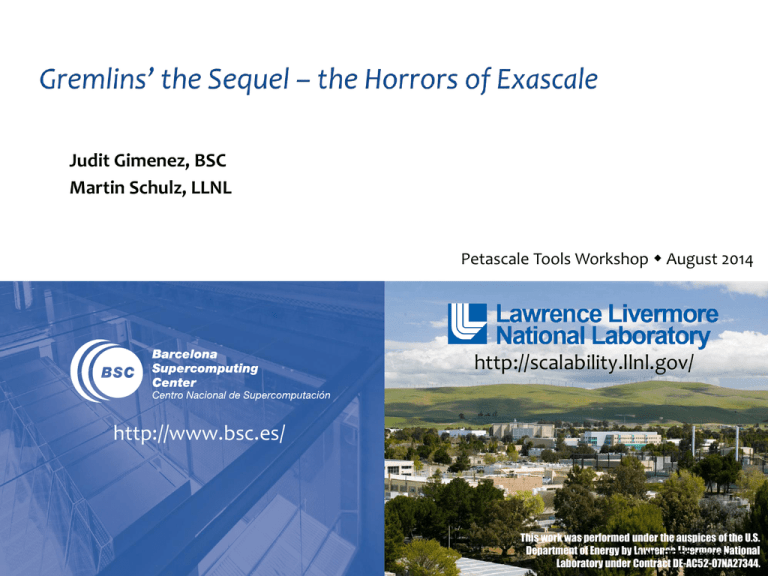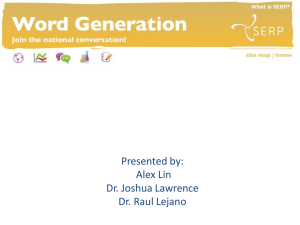pptx - Paradyn
advertisement

Judit Gimenez, BSC Martin Schulz, LLNL Petascale Tools Workshop August 2014 http://scalability.llnl.gov/ http://www.bsc.es/ This work was performed under the auspices of the U.S. Department of Energy by LLNL-PRES-xxxxxx Lawrence Livermore National Laboratory under Contract DE-AC52-07NA27344. Can we make a Petascale class machine behave like what we expect Exascale machines to look like? • Limit Resources (power, memory, network, I/O, …) • Increase compute/bandwidth ratios • Increase fault rates and lower MTBF rates In short: release GREMLINs into a petascale machine Goal: Emulation Platform for the Co-Design process • Evaluate proxy-apps and compare to baseline • Determine bounds of behaviors proxy apps can tolerate • Drive changes in proxy apps to counter-act exascale properties Lawrence Livermore National Laboratory Petascale Tools Workshop Judit Gimenez and Martin Schulz Power • Impact of changes in frequency/voltage • Impact of limits in available power per machine/rack/node/core Memory • Restrictions in bandwidth • Reduction of cache size • Limitations of memory size Resiliency • Injection of faults to understand impact of faults • Notification of “fake” faults to test recovery Noise • Injection of controlled or random noise events • Crosscut summarizing the effects of previous GREMLINs Lawrence Livermore National Laboratory Petascale Tools Workshop Judit Gimenez and Martin Schulz Power • Impact of changes in frequency/voltage • Impact of limits in available power per machine/rack/node/core Memory • Restrictions in bandwidth • Reduction of cache size • Limitations of memory size Resiliency • Injection of faults to understand impact of faults • Notification of “fake” faults to test recovery Noise • Injection of controlled or random noise events • Crosscut summarizing the effects of previous GREMLINs Lawrence Livermore National Laboratory Petascale Tools Workshop Judit Gimenez and Martin Schulz Using RAPL to install power caps • Exposes chip variations • Turns homogenous machines into inhomogeneous ones Optimal configuration under a power cap • Widely differing performance • Application specific characteristics • Need for models Lawrence Livermore National Laboratory Petascale Tools Workshop Judit Gimenez and Martin Schulz Low-level infrastructure • Libmsr: user-level API to enable access to MSRs (incl. RAPL capping) • Msr-safe: kernel module to make MSR access “safe” Current status • Support for Intel Sandy Bridge • More CPUs (incl. AMD) in progress • Code released on github: https://github.com/scalability-llnl/libmsr • Inclusion into RHEL pending • Deployed on TLCC cluster cab Analysis update • Full system characterization (see Barry’s talk) • Application analysis in progress Lawrence Livermore National Laboratory Petascale Tools Workshop Judit Gimenez and Martin Schulz Scheduling research • Find optimal configurations for each code • Balance processor inhomogeneity • Understand relationship to load balancing • Integration into FLUX New Gremlins • Artificially introduce noise events • Network Gremlins — Limit network bandwidth or increase latency — Inject controlled cross traffic Adaptation of the Gremlins to new programming models • Initially developed for MPI (using PnMPI as base) • First new target: OmpSs Lawrence Livermore National Laboratory Petascale Tools Workshop Judit Gimenez and Martin Schulz Gremlins integrated with • OmpSs runtime • Extrae instrumentation (online mode) Analysis of Gremlins’ impact • Living with Gremlins! Measure applications’ sensitivity • Growing our Gremlins! uniform vs. non-uniform populations • Have Gremlins side-effects? — Do they increase/affect variability? — Should not affect other resources First results • Up to now playing with memory Gremlins Lawrence Livermore National Laboratory Petascale Tools Workshop Judit Gimenez and Martin Schulz Marc Casas Gremlins launched at runtime initialization but remain transparent Each gremlin thread is exclusively pinned on one core These processors then become inaccessible by the runtime Runtime parameters can be used to • enable/disable gremlins, • define number of gremlin threads, resource type • how much of that resource a single gremlin thread should use Lawrence Livermore National Laboratory Petascale Tools Workshop Judit Gimenez and Martin Schulz Identify sensitive tasks • Classify how sensitive they are • Match them with tasks that can be run concurrently and are less sensitive to the respective resource type Implement smart Scheduler in OmpSs • Modify OmpSs scheduler to identify resource sensitive tasks with the use of gremlin threads • Implement a scheduler that takes this information into account when scheduling tasks for execution Lawrence Livermore National Laboratory Petascale Tools Workshop Judit Gimenez and Martin Schulz 0 gremlin - 20MB 1 gremlin - 15MB 2 gremlin - 12MB 3 gremlin - 7MB 4 gremlin - 4MB Lawrence Livermore National Laboratory Petascale Tools Workshop Judit Gimenez and Martin Schulz 0 gremlin - 40GB/s 1 gremlin - 37.2GB/s 2 gremlin - 34.3GB/s 3 gremlin - 31.5GB/s 4 gremlin - 28.7GB/s Lawrence Livermore National Laboratory Petascale Tools Workshop Judit Gimenez and Martin Schulz Without gremlins Limiting size (4MB) Limiting bandwidth (28.7 GB/s) Lawrence Livermore National Laboratory Petascale Tools Workshop Judit Gimenez and Martin Schulz 4lnj8dmatvec 8hyn9lpcg Limiting size (4MB) Limiting bandwidth (28.7 GB/s) Lawrence Livermore National Laboratory Petascale Tools Workshop Judit Gimenez and Martin Schulz 8hyn9lpcg Limiting size (4MB) Limiting bandwidth (28.7 GB/s) Lawrence Livermore National Laboratory Petascale Tools Workshop Judit Gimenez and Martin Schulz Limiting bandwidth 4lnj8dmatvec 3hyn9lpcg ahyn9lpcg 8hyn9lpcg Lawrence Livermore National Laboratory Petascale Tools Workshop Judit Gimenez and Martin Schulz Extrae online analysis mode • Based on MRNet Gremlins API to activate them locally • All Gremlins launched at initialization time First experiments with LLC cache size gremlins • Periodic increase of Gremlins • Unbalanced steal of resources Lawrence Livermore National Laboratory Petascale Tools Workshop Judit Gimenez and Martin Schulz Can we extract insight from chaos? • Unbalanced Gremlins creation Lawrence Livermore National Laboratory Petascale Tools Workshop Judit Gimenez and Martin Schulz L3/instr. ratio Lawrence Livermore National Laboratory Petascale Tools Workshop Judit Gimenez and Martin Schulz Different regions show different sensitivity to resource reductions Asynchrony affects actual sharing of resources • Today happens without control variability Detailed analysis detects increases on variability and potential non-uniform impact Lawrence Livermore National Laboratory Petascale Tools Workshop Judit Gimenez and Martin Schulz






